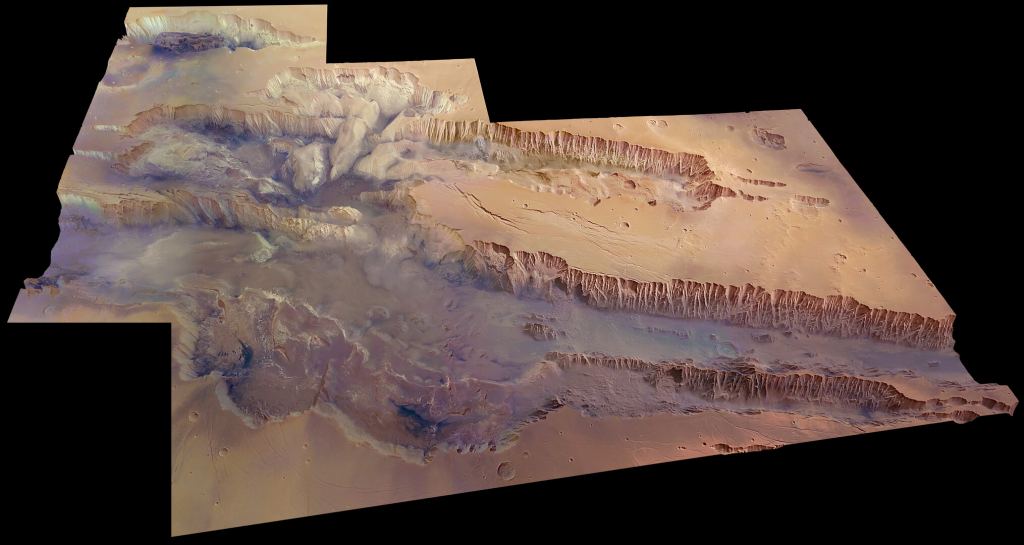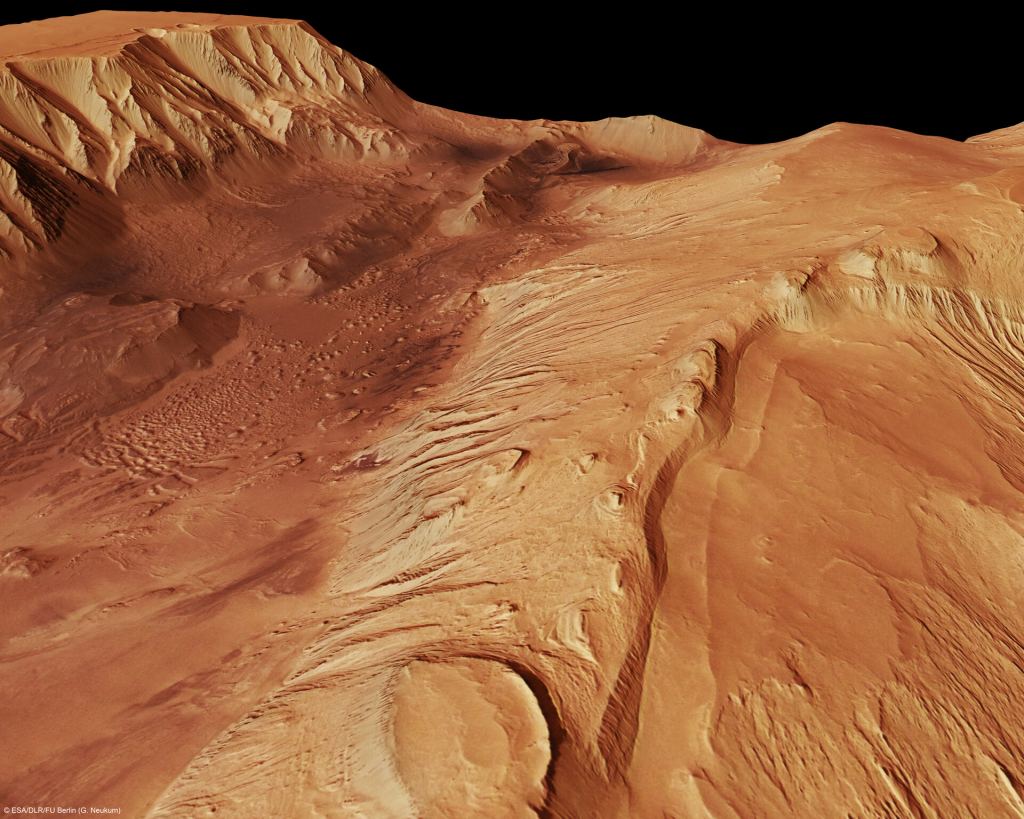For generations, humans have dreamed of the day when we might set foot on Mars. For many others, the dream has been one of settling on Mars and creating an outpost of human civilization there. Today, it looks as though both of these dreams are getting closer to becoming a reality, as space agencies and the commercial space industry are deep into planning regular crewed missions to the Red Planet. And when planning for long-duration missions to destinations in deep space, a vital aspect is assessing the local environment.
For example, missions to Mars will need to be as self-sufficient as possible, which means using local resources to meet the needs of the mission and astronauts – a process known as in-situ resource utilization (ISRU). According to new data from the ESA-Roscomos ExoMars Trace Gas Orbiter (TGO), the massive equatorial canyon known as Valles Marineris (Valley of Mars) contains vast deposits of ice that have remained hidden to scientists until now.
The research was conducted by Dr. Igor Mitrofanov and his colleagues at the Space Research Institute (IKI) of the Russian Academy of Sciences (RAS) in Moscow. They were joined by Håkan Svedhem of the ESA’s European Space Research and Technology Centre (ESTEC) in Noordwijk, Netherlands. The paper that describes their findings – “The evidence for unusually high hydrogen abundances in the central part of Valles Marineris on Mars” – recently appeared in the journal Icarus.

Valles Marineris has been a focal point for climatic studies on Mars for some time. Measuring 4,000 km (2,500 mi) long and up to 7 km (4 mi) deep, it is the largest canyon system in the Solar System. This depth is also why atmospheric pressure at the bottom of the canyon is believed to be higher than most places on Mars – over 1200 Pa. On average, atmospheric pressure on Mars at “sea level” is 0.636 kPa, less than 0.5% of what we experience here on Earth (101.325 kPa).
According to new evidence obtained by the orbiter element of the joint European-Russian ExoMars mission, there is plenty of water ice at the bottom of this valley. This data was obtained as part of a campaign to map the hydrogen content of Mars’ soil by detecting neutrons, a clear sign of water. The ultimate goal is to determine if Mars has water ice locked away in near-surface deposits.
For the sake of their research, the team analyzed data obtained by the TGO’s Fine Resolution Epithermal Neutron Detector (FREND) between May 2018 and February 2021. As co-author Alexey Malakhov of the IKI explained in a recent ESA press release:
“Neutrons are produced when highly energetic particles known as ‘galactic cosmic rays’ strike Mars; drier soils emit more neutrons than wetter ones, and so we can deduce how much water is in a soil by looking at the neutrons it emits. FREND’s unique observing technique brings far higher spatial resolution than previous measurements of this type, enabling us to now see water features that weren’t spotted before.

“We found a central part of Valles Marineris to be packed full of water – far more water than we expected,” he added. “This is very much like Earth’s permafrost regions, where water ice permanently persists under dry soil because of the constant low temperatures.” This data revealed that there’s plenty of water ice in Valles Marineris, which is concentrated in the upper meter (3.3 ft) of the soil.
The water-rich area is comparable in size to the Netherlands and overlaps with Candor Chasma, a tributary valley located in the northern part of the canyon system (also considered a promising area to find near-surface water). As Mitrofanov, who is also the principal investigator of the FREND neutron telescope, expressed:
“With TGO we can look down to one metre below this dusty layer and see what’s really going on below Mars’ surface – and, crucially, locate water-rich ‘oases’ that couldn’t be detected with previous instruments. FREND revealed an area with an unusually large amount of hydrogen in the colossal Valles Marineris canyon system: assuming the hydrogen we see is bound into water molecules, as much as 40% of the near-surface material in this region appears to be water.”
“We found a central part of Valles Marineris to be packed full of water – far more water than we expected. This is very much like Earth’s permafrost regions, where water ice permanently persists under dry soil because of the constant low temperatures.”

At present, it’s unclear how much of this water is in the form of ice versus water that’s chemically bound to minerals in the soil. However, Mitrofanov, Malakhov, and their colleagues believe that what FREND detected is more likely in the form of water ice. This is based on other observations that show how minerals in this region of Mars contain only a few percent water, much less than what these observations indicated.
Similarly, Mars’ equatorial band observations show that water ice and chemically-bound water usually sublimates because of the local temperature and pressure conditions. In short, the stability of water and other volatiles in the region requires the right combination of temperature, pressure, and hydration. This suggests that there must be some special combination of conditions in Valles Marineris that is not well-understood at this time.
It could also mean that the local water is being replenished somehow, perhaps by underground sources or by wind-born water vapor deposited in the valley. Said co-author Svedhem, a former ESA project scientist for the ExoMars Trace Gas Orbiter:
“This finding is an amazing first step, but we need more observations to know for sure what form of water we’re dealing with. Regardless of the outcome, the finding demonstrates the unrivalled abilities of TGO’s instruments in enabling us to ‘see’ below Mars’ surface – and reveals a large, not-too-deep, easily exploitable reservoir of water in this region of Mars.”
In recent years, evidence of water ice has been detected deep underground by the ESA’s Mars Express around the mid-latitudes and deep pools of liquid water under Mars’ south pole. The NASA Mars Reconnaissance Orbiter (MRO) also detected evidence of water ice in the mid-latitudes where steep slopes created by erosion exposed substantial quantities of ice. However, these stores lie up to a few km underground, making them less accessible to exploration missions.
In the near future, several missions are headed to Mars that will land at lower latitudes to characterize the local environment, including the ESA-Roscosmos ExoMars 2022 mission. Like its predecessor, this mission will include the ESA’s Rosalind Franklin rover and the Russian surface platform, Kazachok. These missions will join existing surface missions, like NASA’s Curiosity and Perseverance rovers.
This latest finding makes Valles Marineris an attractive option for future robotic missions and even more promising for future human exploration missions. Says Colin Wilson, ESA’s ExoMars Trace Gas Orbiter project scientist:
“This result really demonstrates the success of the joint ESA-Roscosmos ExoMars programme. Knowing more about how and where water exists on present-day Mars is essential to understand what happened to Mars’ once-abundant water, and helps our search for habitable environments, possible signs of past life, and organic materials from Mars’ earliest days.”

